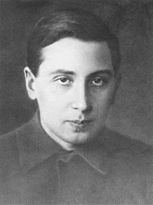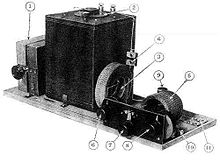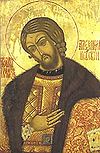- Oleg Losev
-
Oleg Vladimirovich Losev
Олег Владимирович Лосев
Born May 10, 1903
Tver, RussiaDied January 22, 1942
Leningrad, RussiaResidence Nizhny Novgorod, Leningrad Citizenship Russia, Soviet Union Fields Physics, electrical engineering Institutions Nizhniy-Novgorod Radio Laboratory (NRL), Central Radio Laboratory (TSRL, Leningrad), Leningrad Physicotechnical Institute, First Leningrad Medical Institute Known for Inventions, radio, LEDs Oleg Vladimirovich Losev (Russian: Олег Владимирович Лосев) (May 10, 1903 - January 22, 1942) was a scientist and inventor.[1][2] He was born to a high-ranking family in Imperial Russia. He published a number of papers and patents during his short career. His observations of LEDs languished for half a century before being recognized in the late 20th and early 21st century. In 1907, H. J. Round made a very brief report (only 2 paragraphs) in Electrical World regarding light coming from SiC by electrical excitation.[3] Losev's papers provided much more detailed information than Round.
Contents
Light-emitting diodes
In course of his work as a radio technician, he noticed that crystal diodes used in radio receivers emitted light when current was passed through them. In 1927, Losev published details in a Russian journal of the first-ever[citation needed] light-emitting diode.
In the period of 1924 and 1941, he published a number of articles detailing the function of a device that he developed, which would generate light via electroluminescence when electrons fall to a lower energy level. For example, he published an important paper in Philosophical Magazine. [4]
In 1951, Kurt Lehovec et al. published an important paper in Physical Review. Losev's papers were cited but his name appeared as Lossew. Kurt Lehovec's theoretical explanation is much better than Losev's. [5]
Both Round and Losev experimented with SiC which was used as a radio detector in the early days of wireless. However, SiC is an indirect bandgap semiconductor and so inefficient as a material for light-emitting diode. GaN is a direct bandgap semiconductor and so expected to be the more efficient material. The light from even modern SiC LED is somewhat faint but the light from InGaN LED can be dazzlingly bright. Thus neither Round's nor Losev's pioneering work, even if it had been continued, was likely to lead to a practical success.
In the April 2007 issue of Nature Photonics, Nikolay Zheludev gives credit to Losev for inventing the LED.[6][7] Specifically, Losev patented the "Light Relay" [8] and foresaw its use in telecommunications.
Unfortunately, before this device could be developed, the Second World War intervened, and Losev died in 1942 during The Siege of Leningrad (now St. Petersburg), at the age of 39.
Other contributions
 Crystodyne. View of an experimental panel with a generator and a crystal detector, collected in the laboratory of "News Radio ". In the picture numbers denote the following parts: 1 - vario 2 - variable capacitor, 3 - Cellular coil, 4 - condenser 5nF 5 - Throttle 6 - Potentiometer; 7 - Switch 8 - Resistance 9 - Detector zinc-steel, 10 - the headphone jack, 11 - jack batteries.
Crystodyne. View of an experimental panel with a generator and a crystal detector, collected in the laboratory of "News Radio ". In the picture numbers denote the following parts: 1 - vario 2 - variable capacitor, 3 - Cellular coil, 4 - condenser 5nF 5 - Throttle 6 - Potentiometer; 7 - Switch 8 - Resistance 9 - Detector zinc-steel, 10 - the headphone jack, 11 - jack batteries.
In the early 1920s Russia, devastated by civil war, Oleg Losev was experimenting with applying voltage biases to various kinds of crystals, with purpose to refine the reception. The result was astonishing - with a zincyte (zinc oxide) crystal he gained amplification. This was negative resistance phenomenon, decades before the tunnel diode. After the first experiments, he built regenerative and superheterodyne receivers, and even transmitters. However, this discovery was not supported by authorities and soon forgotten and no device was produced in mass quantity beyond a few examples for research. Crystadine was produced in primitive conditions; it can be made in a rural forge - unlike vacuum tubes and modern semiconductor devices.[1]
References
- ^ a b М. А. Новиков (2004). "Олег Владимирович Лосев — пионер полупроводниковой электроники" (PDF). Физика Твердого Тела 46 (1): 5–9. http://www.ioffe.ru/journals/ftt/2004/01/p5-9.pdf. Retrieved 2008-01-01. Lay summary – Babelfish translation: "Oleg Vladimirovich Losev - Pioneer of the Semiconductor Electronics" in Solid State Physics.
- ^ Available in English in: M. A. Novikov (January 2004) "Oleg Vladimirovich Losev: Pioneer of Semiconductor Electronics," Physics of the Solid State, vol. 46, no. 1, page 1-4.
- ^ Henry Joseph Round (9 February 1907) "A note on carborundum," Electrical World, vol. 49, page 309. The text of this note is reproduced in full on Wikipedia's entry: H. J. Round .
- ^ O.V. Lossev (November 1928). "Luminous carborundum detector and detection effect and oscillations with crystals". Philosophical Magazine, Series 7 5 (39): 1024–1044. doi:10.1080/14786441108564683. http://www.tandfonline.com/doi/abs/10.1080/14786441108564683.
- ^ K. Lehovec, C.A. Accardo and E. Jamgochian (1951-08-01). "Injected light emission of silicon carbide crystals". Physical Review 83 (3): 603–608. Bibcode 1951PhRv...83..603L. doi:10.1103/PhysRev.83.603.
- ^ Nikolay Zheludev (2007). "The life and times of the LED — a 100-year history". Nature Photonics 1 (4): 189–192. Bibcode 2007NaPho...1..189Z. doi:10.1038/nphoton.2007.34. http://www.orc.soton.ac.uk/fileadmin/downloads/100_years_of_optoelectronics__2_.pdf. Retrieved 2007-04-11.
- ^ Tom Simonite (2007-04-11). "The LED – older than we thought". NewScientist Blogs. http://www.newscientist.com/blog/technology/2007/04/led-older-than-we-thought.html. Retrieved 2007-04-11.
- ^ Soviet patent #12191 granted in 1929
External links
- Facsimile of "Light Relay" and other Oleg Losev's patents — from Russian Patents blog
People from Russia Leaders and religious - Pre-1168
- 1168–1917
- 1922–1991
- 1991–present
- RSFSR leaders
- General secretaries
- Soviet premiers (1st deputies)
- Soviet heads of state (and their spouses)
- Prime ministers (1st deputies)
- Foreign ministers
- Prosecutors general
- Metropolitans and patriarchs
- Saints

Military and explorers - Field marshals
- Soviet marshals
- Admirals
- Aviators
- Cosmonauts
Scientists and inventors - Aerospace engineers
- Astronomers and astrophysicists
- Biologists
- Chemists
- Earth scientists
- Electrical engineers
- IT developers
- Linguists and philologists
- Mathematicians
- Naval engineers
- Physicians and psychologists
- Physicists
- Weaponry makers
Artists and writers Sportspeople Chess playersCategories:- 1903 births
- 1942 deaths
- Russian physicists
- Russian inventors
- Light-emitting diode pioneers
- Russian electrical engineers
- Soviet physicists
Wikimedia Foundation. 2010.
